Although Amazon does not make sales numbers of its Kindle eReaders public, and it is fashionable in some quarters to announce the death of eBooks, it seems as if sales of Kindles (by far the dominant brand) and eReaders generally have stabilized and may even have grown slightly over the last year. That is good news for E Ink, for whom eReader displays remain an important market, but companies don’t grow by limiting themselves to a mature market.
So the company is energetically exploring and, in selected cases penetrating new markets, said E Ink Deputy Chief Strategy Officer Paul Alpen (Fig. 1). Some of these directions could be seen in the technology demonstrations and customer products E Ink was showing in its South Hall meeting room at CES.
 1. E Ink Deputy Chief Strategy Officer Paul Alpen said at CEWS that E Ink is expanding into new markets for its electrophoretic displays. (Photo: Ken Werner)
1. E Ink Deputy Chief Strategy Officer Paul Alpen said at CEWS that E Ink is expanding into new markets for its electrophoretic displays. (Photo: Ken Werner)
Among the customer products was a batteryless RFID price tag by Powercast that supports reconfigurable pricing.
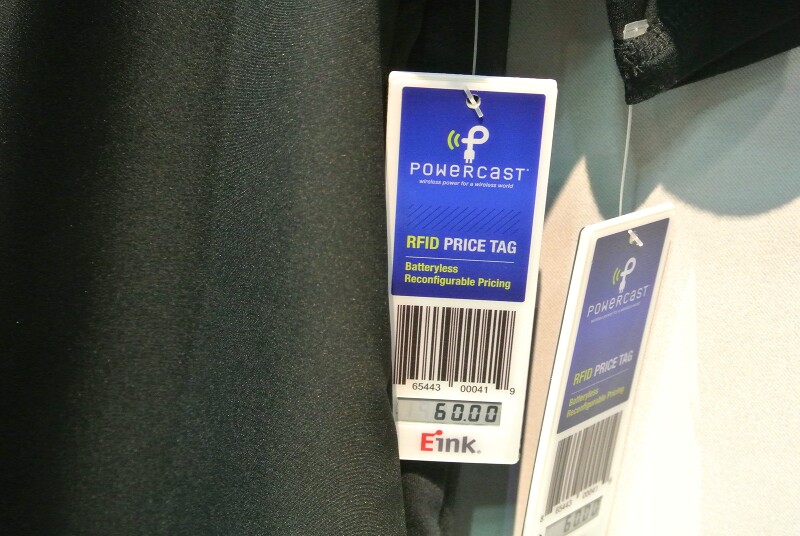 2. Powercast RFID price tag using an E Ink display. (Photo: Ken Werner)
2. Powercast RFID price tag using an E Ink display. (Photo: Ken Werner)
The GVIDO Terrada Music Stand is an eReader for sheet music that uses E Ink’s Mobius flexible plastic TFT substrate, which is “the first plastic-based TFT product offered in mass production,” according to E Ink. The Terrada uses two 13.3″ displays in a book-like format, each of which has 1200 x 1600 pixels for 150 ppi (Fig. 3). The concept of an E Ink music stand was developed some years ago at E Ink. Now, it’s a product.
Fig 3. The GVIDO Terado music stand contains two 13.3-inch E Ink displays and stores sheet music for multiple compositions.
Among the watches and athletic bands on display were the Sony FES Watch U, introduced in 2017, which uses the Mobius E Ink display (Fig. 4, left). The display is on the band as well as the watch face. The Soprod eMovement Hybrid, has analog hands over a 1.1-inch, 240 x 240, E Ink Mobius display (Fig. 4, right). The pixel density is 218 ppi.
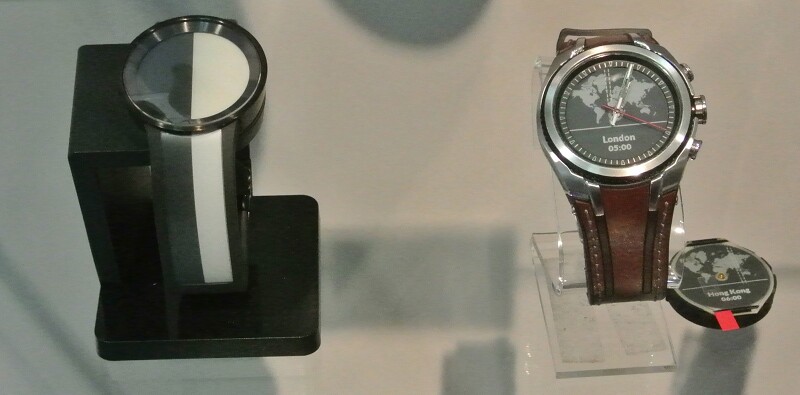 Fig. 4. E Ink’s Mobius plastic substrate is used by Sony and Saprod in these two very different watches. (Photo: Ken Werner)
Fig. 4. E Ink’s Mobius plastic substrate is used by Sony and Saprod in these two very different watches. (Photo: Ken Werner)
A recent product category is an oversized eReader that permits drawing, writing, and editing on the display surface. Units from reMarkable and Sony were on display, and both provided a surprisingly paper-like feel between stylus and display surface, the result of considerable development work, said Alpen. The reMarkable Tablet (Fig. 5) uses a 10.3-inch Carta display with 1872 x 1404 pixels (226 ppi). The Sony DPT-RP1 (Fig. 5B) uses a 13.3-inch E Ink Mobius display display with 2200 x 1650 pixels (212 ppi). (Note: Since “Mobius” refers to the backplane and substrate, and “Carta” refers to front plane and addressing scheme, both of these tablets could well be using the Carta technology.)
 Fig 5. The reMarkable Tablet is both an eReader and eWriter. (Photo: Ken Werner)
Fig 5. The reMarkable Tablet is both an eReader and eWriter. (Photo: Ken Werner)
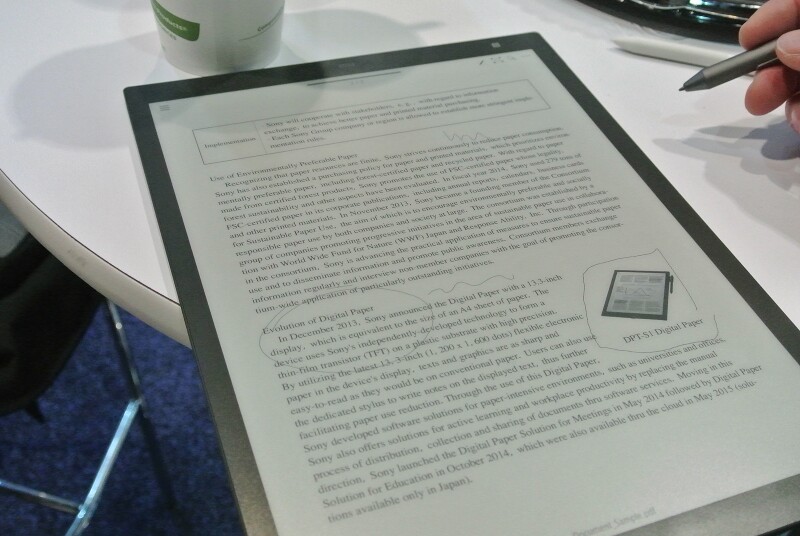 The Sony DPT-RP1 fits into the same general category as the reMarkable Tablet, but has a larger 13.3-inch E Ink display with 2200 x 1650 pixels. (Photo: Ken Werner)
The Sony DPT-RP1 fits into the same general category as the reMarkable Tablet, but has a larger 13.3-inch E Ink display with 2200 x 1650 pixels. (Photo: Ken Werner)
The eLearning Tablet from Okay (Fig. 6) is a notebook PC with a conventional LCD where you would expect to find it and a 9.7″ E Ink Carta display with 1200 x 825 pixels (150 ppi) where you would ordinarily find a keyboard. This display can be a soft keyboard or it can present a variety of digital learning programs.
 Fig 6. The OKAY eLearning Tablet uses a standard notebook PC configuration, except it has an E Ink display in place of the keyboard. (Photo: Ken Werner)
Fig 6. The OKAY eLearning Tablet uses a standard notebook PC configuration, except it has an E Ink display in place of the keyboard. (Photo: Ken Werner)
At the last SID Display Week in May 2017, E Ink showed a flexible display. At CES, the 10.3″ display with 1872 x 1404 pixels (226 ppi) was incorporated in demonstration foldable eReader (Fig. 7). The display’s folding radius is not extremely small, but that does not prevent the concept from being an appealing one (Fig. 8).
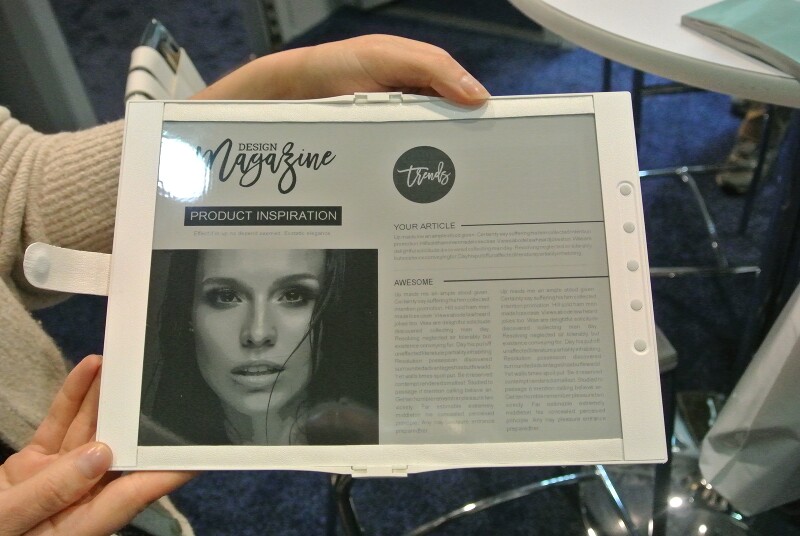 Fig 7. This E Ink prototype for a flexible eReader uses the flexible display shown at SID Display Week 2017.
Fig 7. This E Ink prototype for a flexible eReader uses the flexible display shown at SID Display Week 2017.
 Fig 8. Although the display does not have a very small radius of curvature, it is small enough to support the application. (Photo: Ken Werner)
Fig 8. Although the display does not have a very small radius of curvature, it is small enough to support the application. (Photo: Ken Werner)
Finally, the company was showing framed fine art on a 32″, 94-ppi version of the advanced color ePaper display introduced at the last Display Week (Fig. 9). There was no opportunity for a side-by-side comparison, but the impression was of a “painting-like image” rather than a “display-like image.” It would be very interesting to see an original painting side-by-side-by-side with its images on color E Ink, OLED, and QLED displays. Perhaps the Los Angeles County Museum of Art LACMA) would cooperate during Display Week 2018? I would suggest using Rembrandt’s Portrait of Martin Looten, which is in LACMA’s collection. — Ken Werner
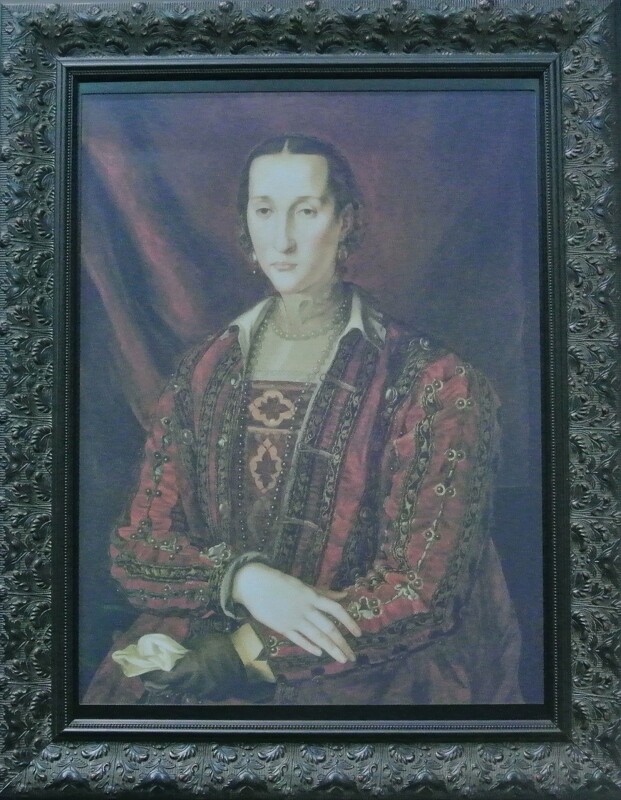 Fig 9. Is it a painting, or is it a color E Ink display? (Photo: Ken Werner)
Fig 9. Is it a painting, or is it a color E Ink display? (Photo: Ken Werner)

